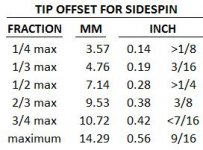I've often wondered how to convey what "put a 1/2 tip or 1 tip of english" really means to other people when trying to convey to 'students of pool' how (and for that matter where on the CB) to place english ... ie off center CB. This makes my point pretty clear with these two related conversations
In
SFC9Ball (
Jim Baker-PBIA Advanced Instructor) Post #9 in this threat states:
.."Spin comes from striking the cue ball on the horizontal axis up to 3 tips (
1 tip = 3.78mm or the circumference of the circle in the red circle cue ball) and how firm you strike the cue ball. There are many myths in pool out there that are just not true."
Stating 1 tip (of English) = 3.78 mm off of CCB... Fast forward to BOB Meucci's definition of appling english in his video on testing his "mechanical swing arm" testing at CCB... seen in this video at 5:54m
https://www.youtube.com/watch?v=ke_Dnfko_Vs&feature=youtu.be
Note here Bob M states that he's (the mechanical stroke arm) appling right english at 3/16" off CCB (or "slightly less than 1/2 tip english")... A quick google search finds 3/16" is 4.7625 mm. That would make
a full 1 tip of english = to 9.52 mm.
So if I'm shooting with say a 12mm shaft (say my MezzWX900), how do I know when I'm putting a 1/2 tip of english on the CB ... which is 6mm off center? According to Jim post above that's almost 2 full tips... (2 X's 3.78= 7.56mm)
What about a 14mm or a 10.5 mm shaft?
Seems to me that there is no standard way to convey to put 'a half tip or a whole tip' outside english and have it mean the same thing for any 2 different people/instructors etc.. [This is without regard to tip speed (10mph or 2mph) or Shaft type or even tip shape or even chalk characteristics or CB Surface dirtiness.]
Just saying.. The Language of Pool in one's mind (the 'feel of it') is hard enough to quantify but the mathematical language should not have this must diversity OR we'll just keep talking past one another...
R
What is 1/2 tip anyway? Really...
Standardize it!


